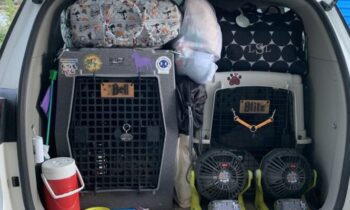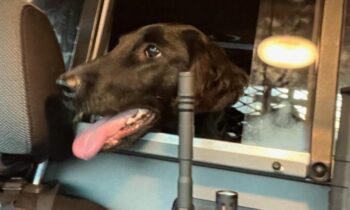

So many newly adopted pets that have been placed through shelters or rescues have already had basic veterinary care before they go to their new homes—shots, spay/neuter, even nail trims and bathing. It’s not surprising that adopters might think there’s no need to schedule another vet visit right away. Everything that needs to be done has been done!
What new pet guardians need to know is the importance of finding the right vet for their new pet—now.
Many veterinarians and veterinary clinics offer what’s often called a well-pet visit, for pets who have just been adopted through a shelter or rescue program, at no charge.
▪ What’s covered in a well-pet visit?
▪ What sort of guidance will new pet guardians receive?
▪ What conditions and concerns not found through the health care the pet has already received might be revealed at a well-pet visit?
(I’m thinking about placements in which the pets have been “imported” by shelters/rescues from areas far away, with the possibility of infections, parasites, and other issues not found locally affecting the animal’s health now in its new home.)
▪ How can a well-pet visit give new pet guardians the chance to “audition” veterinarians and veterinary staff?
I encourage new pet guardians to understand the importance of taking advantage of well-pet visit opportunities to find the right vet for their new pet—now, before there’s anything “wrong”!
Isabel Alvarez Arata (Texas) I love this topic, thank you! I can’t think of a better way for a new pet parent to start their adoption journey than with a well-visit. Rescues can only do so much to prepare them for the experience; a vet well-visit can set them up for even greater success.
Harve Morgan (California) When getting any pet, one needs to establish a relationship with a vet. If you have an emergency, you will find it difficult to get a vet to see you after hours unless you are an established patient. Even if my pets don’t need to see a vet, I will go to a selected vet and do all the paperwork prior to any visits. I also will research the diplomas and organizations of that vet.

Photo by Jessica Theisen de Gonzalez
Ruth L. Heller DVM (Pennsylvania) A well-pet visit …
A) Gets you established as a client before a crisis occurs. This can be a factor in getting in quickly when it is needed. I know my staff and I are more willing to stay late or give up lunch for someone we know.
B) Allows your pet to gain a little familiarity with the facility and staff with a positive experience involving petting and treats, instead of having to visit a new place and strange people while ill or injured.
C) Allows us to become familiar with your animal’s normal exam and behavior so that changes can be noted more easily.
D) Allows you to be familiar with the route and travel time before it is an emergency.
A well-pet visit with me involves getting weighed—yes, that can be scary. Evaluation of records so that any missed items can be caught up and any history noted—best done while the pet decompresses by sniffing around or relaxing with pheromones.
A gentle exam and treats if accepted are a must.
I had one new patient whose first six visits involved him just being there while his owner and I chatted. He went from cowering under the chairs to coming out cringing to confidently coming over for scratches and treats and allowing examination at the end of that.
I had another whose first visit involved a wound that had to be addressed and who was terrified and unhappy to see us the rest of her life.
Having positive initial interactions makes a huge difference.
Jennifer Grant (New Mexico) Just do what the animal is comfortable doing as step one. That may just be working on treats near and in car if they are afraid of car. If the animal is less afraid, it may be going to vet office at quiet time and just getting treats from staff and vet. Later at another visit, build up to getting on the scale with treats and maybe a little gentle handling with vet while giving treats. So many animals end up terrified at the vet office; it is worth finding the gentle, patient vet and going slow.
Jules Weber (Virginia) We just moved out of state. And I searched for a vet a month before we actually moved. We found a really good mobile vet, because Tirion our Swissy had breakthrough seizures every time he went in to our last vet. We never figured out why; it could have been excitement (he actually loved going to the vet), or the smell of a cleaning product. So when we moved, we decided to go with a mobile vet. Anyway, we scheduled everyone. Tirion (obviously), Pretzel my service dog (Lab), and our two cats (DSH) were all seen the day she got here. (Mostly to establish care.) Mainly I wanted to see how she interacted with everyone. Did she have patience? Was she gentle with our shy cats? I even had her trim everyone’s nails too just to squeak in a little additional handling. And she was everything I ever wanted in a vet! We are so happy we found her. About halfway through the appointment she commented something about how well-behaved and happy our fuzzies were. And how easy everything was to do. It was then I admitted my behavior and training background. (I intentionally didn’t mention it before then.) And we just had the best conversation. TLDR: You need to have trust and respect for anyone who’s a constant in your animal’s lives (or at least I do). So seeing first-hand how someone works with your fuzzy is one of the best ways to really see someone. Our new vet passed with flying colors!
Well-Pet Visits: Quotations from Veterinary Websites
“When a dog or cat is adopted from the shelter, he/she is most likely current on vaccines, has been spayed or neutered and has been microchipped. The shelters work hard to make adopting a pet as easy as possible. However, it is still very important to follow up with your veterinarian soon after adoption.
“A thorough wellness exam is necessary to ensure your new pet is as healthy as possible before bringing him/her into your home and possibly introducing him/her to your other pets. If a pet comes to the shelter and is already spayed or neutered, he/she is often examined only by a veterinary technician. If this is the case, the heart and lungs have not been listened to, the eyes, ears and mouth have not been examined and the body has not been palpated for abnormalities.
“Additionally, vaccines for puppies and kittens are given in a series.This means that while a newly adopted puppy or kitten may be current on his/her vaccines now, he/she will need additional vaccinations to stay up to date.
“A visit with your veterinarian may also include a fecal exam to check for intestinal parasites and a blood panel to use as a ‘baseline’ and to check internal organ function. During the exam, your veterinarian will also review diet, behavior concerns and preventative medicine, such as flea control.
“In short, a complete wellness exam is vital to ensuring your new companion is happy and healthy!”
“When you adopt a dog or cat from a shelter, they have most likely already received some degree of medical care. But there’s no guarantee on what procedures or vaccines your new pet has received. Protocols and medical care options can vary from shelter to shelter and even from pet to pet, depending on when they arrived at the shelter, as well as a few other factors like age, gender, and health status.
“A dog or cat you adopt from a shelter may already have received some vaccines, have been spayed or neutered, and have been microchipped. Shelters work diligently to make the adoption process as seamless as possible, ensuring that the basic health needs of the pets are met before they go to their new homes. However, it is crucial to follow up with your veterinarian soon after adoption. While the shelter’s initial medical care is essential, a thorough veterinary examination is necessary to establish a comprehensive health baseline for your new pet. A thorough veterinary exam will help identify any underlying health issues that may not have been apparent during the shelter’s evaluation and will provide an opportunity to discuss a long-term care plan tailored to your pet’s specific needs.
“Initial visits like these with your new pet are also a great opportunity to ask questions and get recommendations from your veterinarian. At this visit, you can address any behavioral or dietary questions you might have and schedule any follow-up vaccinations that may be required to keep your new pet healthy and protected.”
“Take your new pet to the vet within their first week of being in your possession. Doing so will allow you to get a feel of your new pet, study their behaviors, and monitor their health. If you rush straight to the vet from the shelter or breeder, you may not report the needed information you could have if they settled after a few days.
“Ideally, gather information before the day of your visit. You may need to know whether your pet traveled from another part of the world or a different region in your country. It is essential that you know whether they have a good appetite or if they have diarrhea or vomit often. You can also talk about how they are responding to potty training. The more information you have, the better your veterinarian can serve your pet.
“It is essential to ensure that you have:
▪ Veterinary records from the shelter or previous breeder
▪ A list of concerns or questions you may have
▪ Notes of the type of treats or amount of food you feed them
▪ A carrier or crate lined with towels or clothes smelling like home
▪ Harness or leash and collar
▪ Small treats
▪ A toy
▪ Forms your veterinary gave you that you already filled out
▪ A fresh stool sample
“Make your pet enjoy their experience at the vet and not fear the whole process. Carry their favorite treats and do not overfeed them so they can get excited about the treats they will receive at the vet.
“The veterinary staff will begin by asking you about your pet’s history and how they behave and adapt to being in your home. They will then do a weight check and measure the pet’s respiratory notes, pulse, and temperature. Next, they will perform a physical examination on your pet.
“Expect the veterinary staff to examine how your pet moves around the room. The vet will analyze your pet’s whole body, including nails, feet, skin, eyes, ears, genitalia, and nose. Expect them to open the pet’s mouth to observe their gums, teeth, and other structures. The ears and eyes will also need examination done using instruments for magnification and lighting.
“Your pet’s lymph nodes, organs in the abdomen, and joints will get examined through palpitating. They will also listen to their lungs and heart using a stethoscope. Your pet’s reflexes will also get observed. Your veterinarian may have to collect a stool sample if you do not bring one so they can check for intestinal parasites.
“Your veterinarian may also draw blood samples if your pet is six months to test for heartworm infection. They may also run other lab work depending on what they observe.”
—https://www.westminsterveterinarygroup.com/blog/when-should-you-take-your-new-pet-to-the-vet.html
Bottom line, when you decide to add a new pet to your household, ask for referrals from friends and family for veterinarians and clinics that they recommend so you’ll be ready to make an appointment for a well-pet visit once your new pet has been adopted! Don’t wait — the time to find the right vet for your new pet … is NOW!



